By Wei Tong
At the Cloud Native Technology Summit of The Computing Conference 2018, experts from various industries shared their thoughts on emerging trends such as Internet of Things (IoT), containers, and serverless architecture. According to the speakers, the real challenge does not lie within the technology itself – it's the challenge of unifying all technologies for a sustainable ecosystem. Despite their differences, all the experts agreed on and emphasized the importance of bridging developer communities, roles, and technologies for maintaining a cloud native software ecosystem.
First to present was Dan Kohn, Executive Director of Cloud Native Computing Foundation, who talked about the importance of Continuous Integration (CI) in software development. He illustrated this with the well-known SQLite relational database management system (RDBMS). Despite being one of the most widely used and tested RDBMS, SQLite still has many bugs when applied to production scenarios. In fact, the American Fuzzy Lop (AFL) Fuzzer was able to find 22 SQLite bugs in just 30 minutes. This problem is not limited RDBMS, it affects the entire computing ecosystem. If we look at the ecosystem supported by Linux Foundation, we see vulnerabilities on every layer, including both software and hardware. Even with only 40,000 Source Line of Codes (SLOCs), the Linux Foundation is not immune to bugs and security vulnerabilities
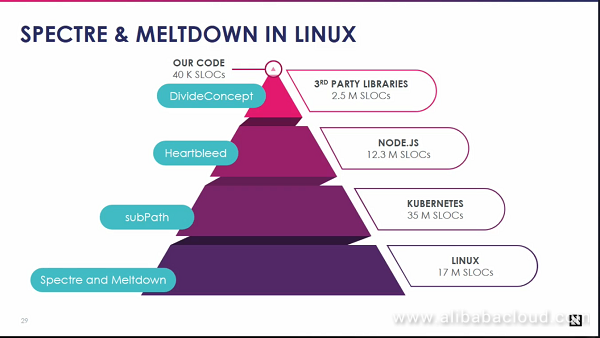
The answer to this problem is Continuous Integration (CI). Normally, software bugs are fixed with patches, but a software patch does not help until we have deployed it into production. In CI, you need to test your apps every time you make a change. By adopting CI, you can have the confidence that a deployment will not break your software. Furthermore, with the power of open source, we have the ability to leverage thousands of other developers that are finding bugs and making fixes to the software that we depend on.
For companies that don't know where to start, Dan provided a simple yet useful piece of advice,
"What kind of test should you run? All of it."
In 2018, the worldwide spending for digital transformation by large enterprises is expected to hit $1.1 trillion USD. The technologist's world has gotten really big, and cloud is undoubtedly changing the way enterprises and customer interact with each other. Developers, engineers, and architects face something new every day, be it a new JavaScript framework or a new platform for development. For technologists, being an expert in a single language is no longer the most important skill. Chip Childers, CTO of Cloud Foundry Foundation, called this skill "cloud cobbling", putting different technologies together for a meaningful solution.
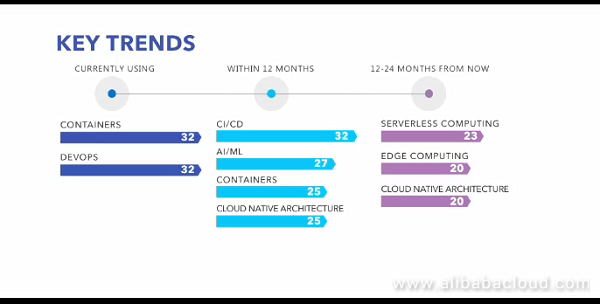
Chip also discussed about the need for bridging different roles for enterprises to successfully adopt a cloud native ecosystem. Despite many enterprises already adopting DevOps and containers, a large majority are yet to adopt CI/CD practices, especially CD (Continuous Deployment). This is because enterprises tend to overlook innovation in favor of relevance. For enterprises, relevant technologies of today such as VMs and big data are more profitable compared with innovative technologies of tomorrow like artificial intelligence (AI) and Internet of Things (IoT).
Continuing the theme of unification, Tao Ma, Principle Engineer of Alibaba Cloud, introduced the concept of "Serverless + Container". According to Tao, by combining these two technologies, we can eliminate the boundary between software developers and operators. Thanks to serverless, users can use containers to seamlessly deploy and migrate their services across on-premises environments and public clouds, without having to worry about the underlying infrastructure.
Tao then talked about building building a simple Kubernetes cluster on Alibaba Cloud ECS. Even though the initial set up is straightforward, upgrading and maintaining it according to business needs can be challenging. For customers, there should be a way for them to quickly deploy apps without caring about these problems. Alibaba Cloud's answer to this problem – Elastic Container Instances (ECI).
Wei Zhang, Staff Engineer of Alibaba Cloud, described the features of the newly launched ECI. With ECI, Alibaba Cloud can deliver serverless computing resources to users via the concept of "container groups", unlike previously monolithic containers. Alibaba Cloud ECI lets you run containers without server management, flexibly consume resources based on demand, and secure applications with sandboxed container runtime.
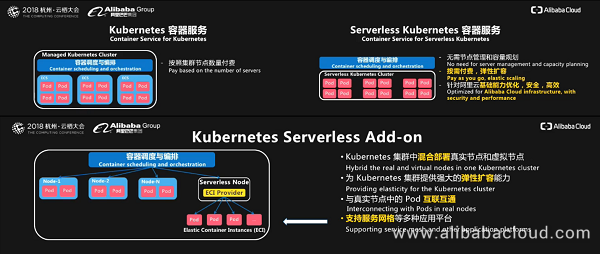
Jason Wu, Principle Engineer of Alibaba Cloud, reiterated the need for serverless computing and introduced Alibaba Cloud's Serverless Platform, which includes products such as Function Compute, Table Store, and Object Storage Service (OSS). However, for Jason, the real challenge is not only about serverless but also to implement a full Function Platform as a Service (FPaaS) on Alibaba Cloud. In fact, 74% of Alibaba Cloud products and services are already serverless. Jason went on by explaining three FPaaS use cases with Alibaba Cloud Function Compute.

Building backend of a web app normally involves buying VMs and designing a load balancer. But with serverless, you just need to use HTTP triggers on API Gateway. Each demand will trigger a function, and within each function you can define the logic to which can point you towards accessing OSS, RDS, or other services. There is no longer the need to manage VMs and dynamic scaling is automated. You don't have to worry about scaling and traffic control, scaling is performed by function.

Data logging is very important for enterprises not only for finding bugs but also to analyze your business. For example, if you want to analyze the click rate for your website, you can use Log Service. As a serverless service, it collects your logs automatically as well as helps you analyze, archive, and send data logs to other services.

Have you ever uploaded and edited a file through your mobile phone? If you have, chances are, your files went through a process called content transform. When you send a file on a messaging app, such as sending a PowerPoint presentation through DingTalk, the content is first uploaded to OSS. Then, if you edit the file, an event is triggered to perform the change. This is all done through Alibaba Cloud's Intelligent Media Management (IMM) service. From a user perspective, you only need to access the file from your app. You don't have to think about the storage service, platform, and conversion processes separately.
In the final session, Xiaoliang Yang, Chief Architect of Siemens IoT Cloud Platform, talked about developing an Internet of Things (IoT) system for industrial applications. In most cases, IIoT is similar to commercial IoT. The biggest difference lies with the scale of IIoT. IIoT not only involves a multitude of sensors but also a large number of stakeholders, all with different business and technological requirements.
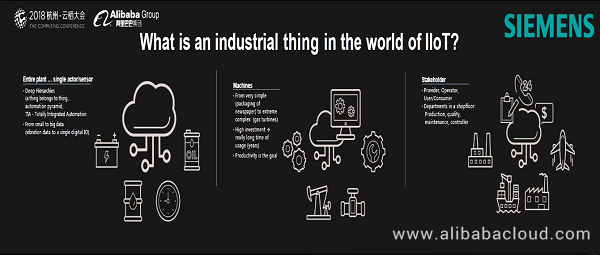
That is why for IIoT, cooperation between all stakeholders is the key. That is why Siemens and Alibaba Cloud officially announced a partnership at The Computing Conference 2018 that defines the technological roadmap and implementation plan for MindSphere's launch in Chinese mainland. MindSphere connects real things to the digital world, and provides powerful industry applications and digital services to help drive business success. Combining Siemens' PaaS capabilities with Alibaba Cloud's IaaS services, MindSphere on Alibaba Cloud will provide a comprehensive platform that offers connectivity, data analytics and industrial knowhow. This in turn will enable enterprises in China to realize novel and data-driven business models.
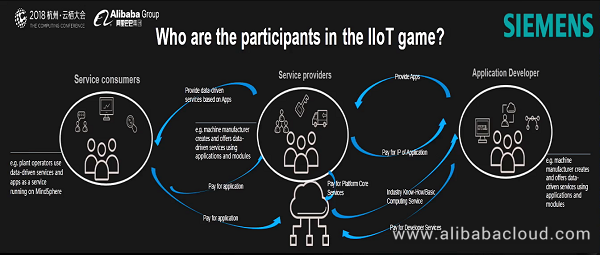
Safeguard Your Blockchain Solution with Chip-Level Security – Alibaba Cloud Blockchain Service
How to Install and Configure SQL Server AlwaysOn on an ECS Instance

2,593 posts | 790 followers
FollowAlibaba Clouder - August 7, 2019
Alibaba Clouder - July 25, 2019
Alibaba Clouder - September 27, 2018
Alibaba Clouder - October 15, 2018
Alibaba Clouder - October 21, 2020
chuan - February 27, 2020

2,593 posts | 790 followers
Follow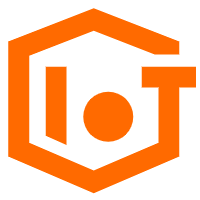 IoT Platform
IoT Platform
Provides secure and reliable communication between devices and the IoT Platform which allows you to manage a large number of devices on a single IoT Platform.
Learn More IoT Solution
IoT Solution
A cloud solution for smart technology providers to quickly build stable, cost-efficient, and reliable ubiquitous platforms
Learn More Global Internet Access Solution
Global Internet Access Solution
Migrate your Internet Data Center’s (IDC) Internet gateway to the cloud securely through Alibaba Cloud’s high-quality Internet bandwidth and premium Mainland China route.
Learn More ACK One
ACK One
Provides a control plane to allow users to manage Kubernetes clusters that run based on different infrastructure resources
Learn MoreMore Posts by Alibaba Clouder